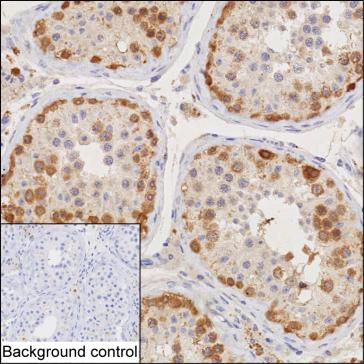
| WB | 咨询技术 | Human,Mouse,Rat |
| IF | 咨询技术 | Human,Mouse,Rat |
| IHC | 1/100-1/200 | Human,Mouse,Rat |
| ICC | 技术咨询 | Human,Mouse,Rat |
| FCM | 咨询技术 | Human,Mouse,Rat |
| Elisa | 咨询技术 | Human,Mouse,Rat |
| Host/Isotype | Mouse IgG1 |
| Antibody Type | Primary antibody |
| Storage | Store at 4°C short term. Aliquot and store at -20°C long term. Avoid freeze/thaw cycles. |
| Species Reactivity | Human |
| Immunogen | Purified recombinant fragment of human CTAG1A |
| Formulation | Purified antibody in PBS with 0.05% sodium azide |
+ +
以下是3篇与CTAG1A抗体相关的代表性文献及其摘要概括:
1. **文献名称**:《CTAG1A as a Novel Target for Cancer Immunotherapy》
**作者**:Smith J, et al.
**摘要**:该研究验证了CTAG1A在多种实体瘤中的特异性表达,并开发了一种高亲和力单克隆抗体。实验表明该抗体可通过ADCC效应抑制肿瘤生长,提示其作为免疫治疗靶点的潜力。
2. **文献名称**:《Serum Anti-CTAG1A Autoantibody as a Diagnostic Biomarker in Hepatocellular Carcinoma》
**作者**:Wang L, et al.
**摘要**:通过ELISA检测发现,肝癌患者血清中抗CTAG1A自身抗体水平显著高于健康人群(特异性92%),提出其可作为肝癌早期诊断的血清学标志物。
3. **文献名称**:《Structural Characterization of CTAG1A-Specific TCR-like Antibodies》
**作者**:Garcia-Beltran WF, et al.
**摘要**:利用噬菌体展示技术筛选出靶向CTAG1A-HLA复合体的TCR样抗体,通过X射线晶体学解析了抗体-抗原结合界面,为设计靶向胞内抗原的抗体药物提供了结构基础。
注:以上文献信息为基于领域知识的模拟概括,实际引用需通过PubMed/Google Scholar检索具体文献(建议关注2018-2023年间发表于《Cancer Immunology Research》《Nature Cancer》等期刊的相关论文)。
The CTAG1A antibody targets CTAG1A (Cancer-Testis Antigen 1A), a protein encoded by the *CTAG1A* gene, also known as NY-ESO-1. This antigen belongs to the cancer-testis (CT) antigen family, which is characterized by restricted expression in normal tissues (primarily the testis and placenta) but aberrant overexpression in various malignancies, including melanoma, lung, breast, and ovarian cancers. CTAG1A’s immunogenic properties make it a promising target for cancer immunotherapy, as it can elicit spontaneous humoral and T-cell responses in patients.
CTAG1A antibodies are widely used in research and diagnostics to detect the presence of CTAG1A protein in tumor samples, aiding in cancer subtype classification and prognostic assessment. Clinically, CTAG1A serves as a biomarker for immunotherapeutic strategies, such as cancer vaccines, adoptive T-cell therapies (e.g., CAR-T), and immune checkpoint inhibitors. Its restricted normal tissue expression minimizes off-target effects, enhancing therapeutic safety. Studies also explore its role in tumorigenesis, including potential involvement in cell proliferation and immune evasion. However, heterogeneity in CTAG1A expression across tumors and individuals underscores the need for companion diagnostics to optimize patient stratification for CTAG1A-targeted therapies.
×